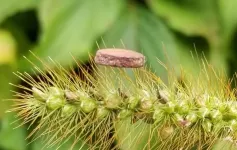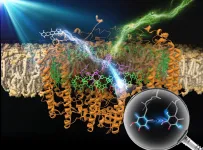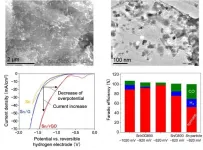(Press-News.org) For scientists, especially graduate students, who conduct fieldwork, every day is precious. Researchers meticulously prepare their equipment, procedures and timelines to make sure they get the data they need to do good science. So you can imagine the collective anxiety that fell across academia in spring 2020 when COVID-19 struck and many universities suspended in-person activities, including fieldwork.
But for Austin Green, a doctoral student in the School of Biological Sciences and 2019 recipient of a National Geographic Society Early Career Grant, who studies the wildlife that lives in the canyons of the Wasatch Front, that anxiety was tempered by the knowledge that pandemic or no pandemic, his network of automated motion-activated trail cameras would keep their silent watch over the canyons' mammals and birds.
Deer and wild turkeys.
"You can set them up at the beginning of the year and leave them up until your field season is over," Green says. "And we were not the only ones that did this. In fact, there were entire nationwide and global initiatives that were able to continue gathering data during pandemic restrictions on field research."
Now Green and his colleagues are sharing what they've learned about the importance of trail cameras for wildlife conservation and management in the journal Biological Conservation. As the COVID-19 pandemic has shown, they write, automatic trail cameras are good tools for a wide range of environments and research questions.
Watching the wildlife
Trail cameras (also called camera traps although they don't trap or restrain anything) are motion-activated cameras that researchers can attach to a tree or pole, usually at knee-height, in remote areas. The cameras then take photos whenever something walks by. Some models transmit photos wirelessly, but many collect photos on an SD card, which researchers like Green change out periodically when they change the camera's batteries. They can also be programmed to capture video to document fascinating vignettes of animal behavior.
Coyote.
"All newer models have exceptional battery life and photo storage capacity," Green says. "So, we set them up before restrictions went into place and kept them up throughout the entire field season, allowing us to gather another full season of data."
Even before the COVID-19 pandemic, biologists were already turning to trail cameras as a way to conduct biological surveys that avoided the difficult, labor-intensive process of physically trapping, tagging and releasing of animals.
"However, with trail cameras, researchers can monitor individual animals passively over a large number of cameras and a large area, as long as the individuals can be individually identified through photographs," Green says. "Cameras do not need to be maintained on a daily basis, and no individual animals ever need to be processed."
Inspiring volunteers
For Green's purposes, trail cameras are perfect. He's looking to study the wildlife that inhabit the canyons of the Wasatch Front, and with the help of a team of more than 200 community volunteers, maintains 300 trail cameras stretching as far north as Logan, Utah and as far south as Point of the Mountain. The cameras have captured images of turkeys, herons, moose, coyotes, cougars and many others.
When COVID-19 restrictions began, Green quickly adapted his operation, moving training materials online and setting up a contactless pick-up method for equipment. Crowdsourced data entry proceeded as it had before. Green calls the efforts of his community volunteers inspiring.
"No matter what changes we threw at them, whether it was going completely online for all non-fieldwork related logistics or having to individually find time to disperse equipment, these amazing people never missed a beat," Green says. "One thing I'll take from this and apply to my research moving forward is that, even in hard times, there are always those willing to do what is necessary to get the job done."
And it was a good thing he and his volunteers were able to keep the cameras running, because the early weeks of the pandemic provided a unique research opportunity.
"The pandemic has created so much hardship and tragedy for so many people, and this can make it difficult to find any silver linings," Green says, "However, the sudden change in human traffic, deemed by scientists as the 'anthropause,' has presented an opportunity to study how wildlife react to quasi-experimental changes in human influence."
Çağan Şekercioğlu, associate professor in the School of Biological Sciences, says that trail cameras can also perform an important conservation function. While the general public, conservationists, rangers and others often had to stay home due to mandatory lockdowns, trespassers, poachers and illegal loggers continued going into wild areas. "During the lockdown, to this day in many places, trail cameras are our only eyes on the ground," Şekercioğlu says.
A range of research questions
A great blue heron wading in a stream.
Green, Şekercioğlu and colleagues write in Biological Conservation that trail cameras are well-suited for fundamental research questions like investigating the presence, relative abundance, density, occupancy, and activity of animal species. They can be instrumental in discovering the presence of a new species or the expansion of its range. Further, they write, while more cameras are better, even a single camera can yield valuable information.
Trail cameras can go further as well to address questions of human impacts on wildlife, trends in biodiversity, reproductive ecology, behavior and interactions between species, and even which predators are raiding bird nests.
As a research tool, trail cameras are a complement to good research design. "My advice for other researchers will always be to first and foremost clearly articulate the particular question they hope to address and decide what tools can be used to help them address it," Green says. "Although I'm not sure research can ever be fully 'pandemic-proofed' or resistant to disruptions, I can say that being willing, flexible and creative enough to adapt to unique situations will always be critical to the advancement of science. After all, so many great scientific discoveries were unexpected beforehand."
INFORMATION:
Find the full study here.
The largest flightless bird ever to live weighed in up to 600kg and had a whopping head about half a metre long - but its brain was squeezed for space.
Dromornis stirtoni, the largest of the 'mihirungs' (an Aboriginal word for 'giant bird'), stood up to 3m high and had a cranium wider and higher than it was long due to a powerful big beak, leading Australian palaeontologists to look inside its brain space to see how it worked.
The new study, just published in the journal Diversity, examined the brains of the extinct giant mihirungs or dromornithid birds that were a distinctive part of the Australian fauna for many millions of years, before going extinct around 50,000 ...
During the COVID-19 pandemic, people have grown accustomed to wearing facemasks, but many coverings are fragile and not easily disinfected. Metal foams are durable, and their small pores and large surface areas suggest they could effectively filter out microbes. Now, researchers reporting in ACS' Nano Letters have transformed copper nanowires into metal foams that could be used in facemasks and air filtration systems. The foams filter efficiently, decontaminate easily for reuse and are recyclable.
When a person with a respiratory infection, such ...
Nature produces a startling array of patterned materials, from the sensitive ridges on a person's fingertip to a cheetah's camouflaging spots. Although nature's patterns arise spontaneously during development, creating patterns on synthetic materials is more laborious. Now, researchers reporting in ACS Central Science have found an easy way to make patterned materials having complex microstructures with variations in mechanical, thermal and optical properties -- without the need for masks, molds or printers.
In animals, patterns form before birth ...
Honeybees play a scent-driven game of telephone to guide members of a colony back to their queen, according to a new study led by University of Colorado Boulder. The research, published today in the Proceedings of the National Academy of Sciences, highlights how insects with limited cognitive abilities can achieve complex feats when they work together--even creating what looks like a miniature and buzzing version of a telecommunications network.
The findings also serve as a testament to a honeybee's love for its queen. These matriarchs are the most important members of any hive: They're the only females able ...
Given the finite nature of fossil fuel reserves and the devastating environmental impacts of relying on fossil fuels, the development of clean energy sources is among the most pressing challenges facing modern industrial civilization. Solar energy is an attractive clean energy option, but the widescale implementation of solar energy technologies will depend on the development of efficient ways of converting light energy into chemical energy.
Like many other research groups, the members of Professor Takehisa Dewa's research team at Nagoya Institute of Technology in Japan have turned to biological photosynthetic apparatuses, which ...
[Background]
Decreasing the emission and efficient utilization (fixation) of carbon dioxide (CO2) are worldwide issues to prevent global warming. Promotion of the use of renewable energy is effective in reducing CO2 emissions. However, since there are large time-dependent fluctuations and large regional differences in renewable energy production, it is necessary to establish a fixation technology to allow efficient energy transportation and storage. Thus, there is increasing interest in technologies for synthesizing useful chemicals from CO2 using electricity derived from renewable energy. ...
A new study suggests that Sargramostim, a medication often used to boost white blood cells after cancer treatments, is also effective in treating and improving memory in people with mild-to-moderate Alzheimer's disease. This medication comprises of a natural human protein produced by recombinant DNA technology (yeast-derived rhu GM-CSF/Leukine®).
The study, from the University of Colorado Alzheimer's and Cognition Center at the University of Colorado Anschutz Medical Campus (CU Anschutz), presents evidence from their clinical trial that shows that Sargramostim may ...
(Boston)--Being persistently lonely during midlife (ages 45-64) appears to make people more likely to develop dementia and Alzheimer's Disease (AD) later in life. However, people who recover from loneliness, appear to be less likely to suffer from dementia, compared to people who have never felt lonely.
Loneliness is a subjective feeling resulting from a perceived discrepancy between desired and actual social relationships. Although loneliness does not itself have the status of a clinical disease, it is associated with a range of negative health outcomes, including sleep disturbances, depressive symptoms, cognitive impairment, and stroke. Still, feeling lonely may happen to anyone at some point in life, ...
A new study shows that if the population were fixed at current levels, the risk of population displacement due to river floods would rise by ~50% for each degree of global warming. However, if population increases are taken into account, the relative global flood displacement risk is significantly higher.
The research, by an international team from Switzerland, Germany, and the Netherlands, used a global climate-, hydrology- and inundation-modelling chain, including multiple alternative climate and hydrological models, to quantify the effect of global warming on displacement ...
Extremely hot and dry conditions that currently put parts of the UK in the most severe danger of wildfires once a century could happen every other year in a few decades' time due to climate change, new research has revealed.
A study, led by the University of Reading, predicting how the danger of wildfires will increase in future showed that parts of eastern and southern England may be at the very highest danger level on nearly four days per year on average by 2080 with high emissions, compared to once every 50-100 years currently.
Wildfires need a source of ignition which ...





